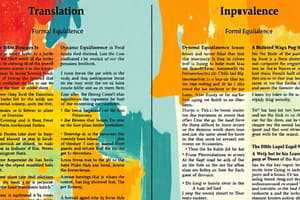Podcast
Questions and Answers
Dynamic Equivalence challenges the translator to balance faithfulness to the original meaning while making the translation natural and acceptable to the target audience.
Dynamic Equivalence challenges the translator to balance faithfulness to the original meaning while making the translation natural and acceptable to the target audience.
True (A)
Free translation allows the translator to deviate from the source language, unlike Dynamic Equivalence.
Free translation allows the translator to deviate from the source language, unlike Dynamic Equivalence.
False (B)
Dynamic Equivalence focuses on mirroring the exact words used in the original text to ensure precision in translation.
Dynamic Equivalence focuses on mirroring the exact words used in the original text to ensure precision in translation.
False (B)
Formal Equivalence is another term for Dynamic Equivalence in translation theory.
Formal Equivalence is another term for Dynamic Equivalence in translation theory.
In Dynamic Equivalence, the second translation mirrors the exact words used in the original text.
In Dynamic Equivalence, the second translation mirrors the exact words used in the original text.
Dynamic Equivalence is applied when the source text is unclear or challenging to understand with a formal equivalence approach.
Dynamic Equivalence is applied when the source text is unclear or challenging to understand with a formal equivalence approach.
Dynamic Equivalence is recommended when formality in translation is crucial and cannot be compromised.
Dynamic Equivalence is recommended when formality in translation is crucial and cannot be compromised.
Formal Equivalence prioritizes adapting the translation to suit the preferences of the target audience.
Formal Equivalence prioritizes adapting the translation to suit the preferences of the target audience.
The primary goal of Dynamic Equivalence is to ensure an identical linguistic structure between the source and target languages.
The primary goal of Dynamic Equivalence is to ensure an identical linguistic structure between the source and target languages.
Formal equivalence focuses on preserving cultural nuances and idiomatic expressions in translation.
Formal equivalence focuses on preserving cultural nuances and idiomatic expressions in translation.
Flashcards are hidden until you start studying




